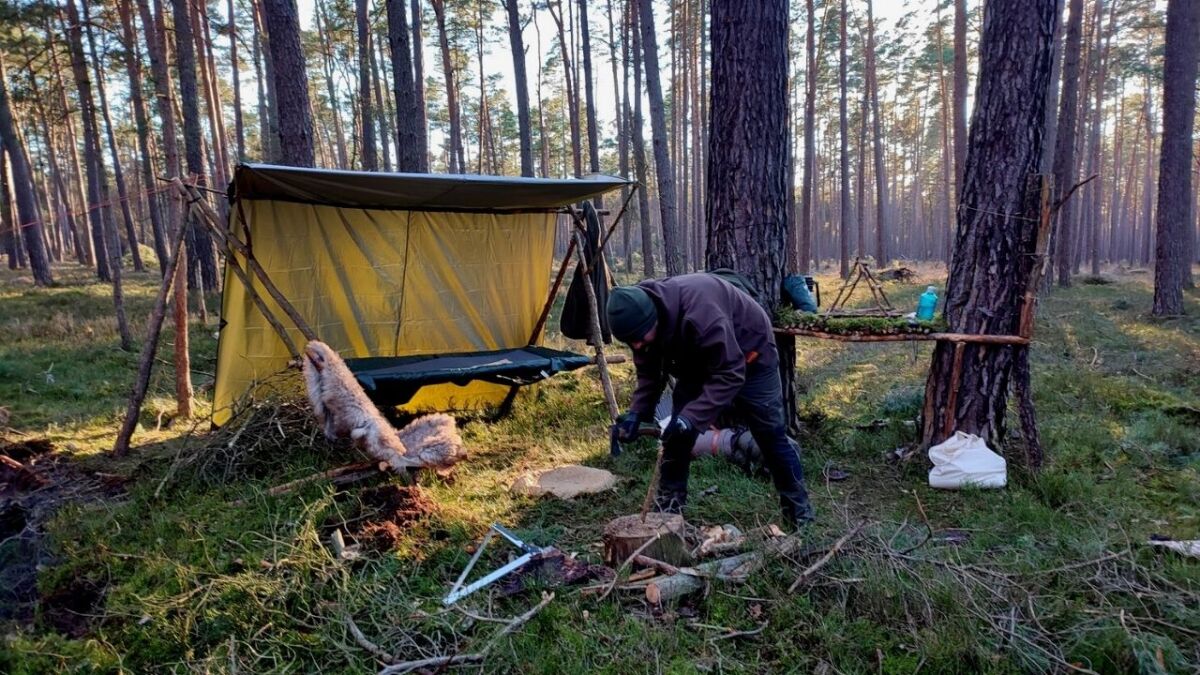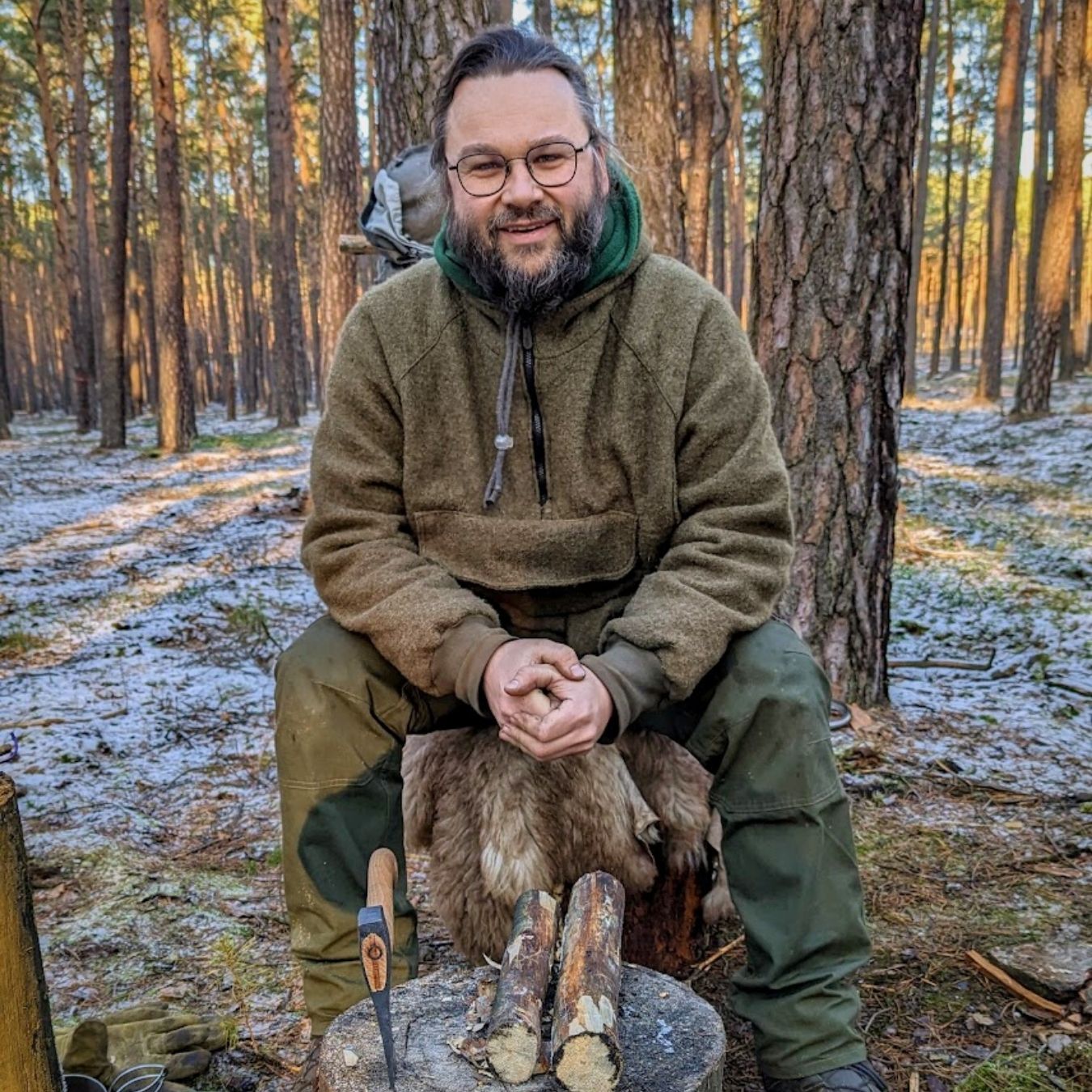
Bushcraft camp
Nomen
Meaning
Bushcraft camp refers to a temporary shelter or living area that is constructed and maintained using natural materials and primitive techniques. It is a fundamental aspect of bushcraft, which focuses on wilderness survival skills and self-reliance in natural environments. A bushcraft camp provides a safe and comfortable space for outdoor enthusiasts to live and thrive in the wild. It is typically built using materials such as branches, leaves, and bark, and may include features like a fire pit, sleeping area, and storage space. Creating and maintaining a bushcraft camp is an essential skill for anyone venturing into the great outdoors.

Examples
„I love spending time in the wilderness, and one of my favorite activities is setting up a bushcraft camp.“
„When I go camping with my friends, we always make sure to build a bushcraft camp to enhance our outdoor experience.“
„Last summer, I attended a bushcraft workshop where I learned how to construct a sturdy and functional bushcraft camp.“
„During my solo hiking trip, I found a perfect spot to set up my bushcraft camp and spent the night under the stars.“
„When I invited my cousin to join me on a bushcraft adventure, he was amazed by the skills required to build a comfortable bushcraft camp.“
Origin
The word "Bushcraft" originates from the combination of "bush" and "craft". "Bush" refers to the wilderness or the natural environment, while "craft" refers to a skill or ability. The term itself has its roots in Australia, where it was used to describe the traditional skills and knowledge of the Aboriginal people in living and surviving in the bush.
Over time, the concept of Bushcraft spread to other parts of the world, particularly in North America and Europe. It became associated with outdoor activities and survival skills, focusing on self-reliance and utilizing natural resources in the wilderness.
A Bushcraft camp is a temporary shelter or living space that is constructed using natural materials found in the surrounding environment. It is typically built in a way that blends with the natural surroundings and provides protection from the elements.
Today, Bushcraft camps are often used by outdoor enthusiasts, survivalists, and those seeking to reconnect with nature. They serve as a base for practicing various wilderness skills, such as fire-making, shelter-building, foraging, and navigation.
Synonyms
Wilderness camp, Survival camp, Outdoor camp, Nature camp, Primitive camp, Backcountry camp, Woodland camp, Rustic camp
Antonyms
City life, Urban living, Civilization, Modern comforts, Technology, Convenience, Comfort, Luxury
Relatives
Wilderness survival, Outdoor skills, Primitive living, Nature craft, Survival shelter, Fire making, Foraging, Woodcraft
Historical and cultural importance
Bushcraft camps have a rich historical and cultural significance, deeply rooted in the traditions of indigenous peoples and early explorers. These camps represent a way of living in harmony with nature, relying on essential survival skills and resourcefulness.
Historically, bushcraft camps were used by indigenous tribes as temporary shelters during hunting and gathering expeditions. These camps were strategically located near water sources and abundant natural resources, allowing the tribes to sustain themselves in the wilderness. The construction of these camps involved using natural materials such as branches, leaves, and animal hides, showcasing the resourcefulness and ingenuity of these communities.
During the age of exploration, bushcraft camps became essential for early explorers and pioneers. These camps provided a safe haven in uncharted territories, allowing explorers to rest, replenish supplies, and plan their next expeditions. The skills required to build and maintain these camps were crucial for survival in the harsh and unpredictable wilderness.
Today, bushcraft camps continue to hold cultural significance as they represent a connection to our ancestral roots and a way to reconnect with nature. They serve as a platform for learning and practicing essential survival skills, self-reliance, and environmental stewardship. Bushcraft enthusiasts and outdoor enthusiasts alike embrace the ethos of bushcraft camps, seeking to immerse themselves in the natural world and develop a deeper understanding of the wilderness.
Whether it's building a shelter, starting a fire, or foraging for food, bushcraft camps embody the spirit of self-sufficiency and resilience. They provide a space for individuals to disconnect from the modern world and reconnect with the primal instincts and skills that have allowed humans to thrive in the wilderness for centuries.
More information about the term Bushcraft camp
Bushcraft Camp
A bushcraft camp is a temporary shelter and living space that is created in the wilderness using natural materials and primitive skills. It is a fundamental aspect of bushcraft and survival, providing a safe and comfortable base for outdoor adventures.
Location and Setup
When choosing a location for a bushcraft camp, it is important to consider factors such as proximity to water sources, availability of firewood, and natural protection from the elements. Once a suitable spot is found, the camp can be set up using various techniques and materials.
One common method is to construct a lean-to shelter using branches, leaves, and other natural materials. This provides a simple yet effective protection against rain and wind. Another option is to build a debris hut, which involves creating a framework of branches and covering it with layers of leaves, grass, and moss.
In addition to the shelter, a bushcraft camp typically includes other essential components such as a fire pit, seating area, and storage space. These are all designed to enhance comfort and functionality while living in the wilderness.
Survival Skills
Building a bushcraft camp requires a range of survival skills and knowledge. These include the ability to identify suitable materials for construction, understanding how to tie knots and lashings, and knowing how to use tools such as knives and axes safely.
Firecraft is also a crucial skill in bushcraft camping. Being able to start a fire using natural materials such as tinder, kindling, and firewood is essential for cooking, warmth, and signaling for help if needed.
Foraging for food and water is another important aspect of bushcraft camping. Knowing how to identify edible plants, find sources of clean water, and safely prepare meals in the wilderness is vital for long-term survival.
Leave No Trace
When practicing bushcraft camping, it is essential to follow the principles of Leave No Trace. This means minimizing your impact on the environment and leaving the campsite as you found it.
Proper disposal of waste, including human waste, is crucial to prevent contamination of water sources and preserve the natural beauty of the area. It is also important to avoid damaging or cutting down live trees and plants unnecessarily.
Conclusion
A bushcraft camp is a testament to human ingenuity and resourcefulness in the wilderness. It allows you to connect with nature, develop essential survival skills, and experience the thrill of self-reliance. Whether you are a seasoned outdoor enthusiast or a beginner in bushcraft, creating and living in a bushcraft camp is an adventure like no other.
Back to overview

